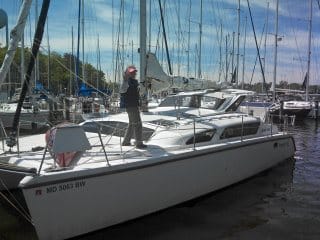
abyc insp sailboats_8671.jpg

One of over 20 boats that participated in our annual boating safety check program
Several weeks ago, (May 4th to be exact) ABYC held it’s annual boating safety check at Port Annapolis Marina. The idea here is to offer a free safety inspection to any and all that choose to participate. ABYC and some of its member surveyors and technical specialists as well as the local Coast Guard Auxiliary work through a series of checklists and create a report for the boat owner’s that give them suggestions for improvement to bring things up to compliance. This year we had 21 boats participate, 16 sail and 5 power boats in all.
What I found particularly interesting about the program this year was that Brian Goodwin, ABYC Technical Director did something this year that we hadn’t thought of last year, he actually compiled data on some of the common faults found. This is useful to me because this list gives me plenty of material to work with and harp about for many weeks to come!
For our part at ABYC, we were focusing on some key areas that our standards address, electrical issues, fuel systems, exhaust systems, seacocks, proper labeling, and LPG systems were all on our radar for each of the boats that attended. Most all of the items on our checklist were things I’ve talked about here on Eds Boat Tips before. That said, because of the frequency of non-compliance found in our relatively small sampling of boats, you’re going to get reminded yet again on some of these items. Compliance is important to ensure on board safety!So, here we go, let the chastising begin!
For this week’s most common non compliant issue we have GFCI’s that either were not installed or not working. As a reminder, these little guys are the electrical outlets with the “trip and Reset” buttons on them. Keep in mind that most boats will have one or maybe two of them that supply downstream outlets in other areas of the boat. It’s common for example to have one of the outlets in the galley that supplies an outlet in the head or perhaps up on deck or in an engine room space. All areas of the boat that are required to have GFCI protection to be compliant with ABYC Standards. These outlets also have some fine print on their face, sound advice that nobody ever follows. Take a close look, it says “Test Monthly” somewhere on the front of these outlets. NOBODY DOES THAT!!
I’ve experimented with this and by tripping and resetting these devices, you actually exercise the mechanical mechanism inside the device. I think the reason they fail so regularly in the marine environment is that the trip mechanism gets corroded and it can’t respond as it should. By testing and resetting regularly, I believe that you actually keep the corrosion at bay and the free movement of the parts in good order. The bottom line on our inspection group was a total of 11 out of 21 boats had either faulty GFCI devices or were not compliant in the first place! This is not a good batting average.
Remember these outlets are the thing that’s going to save you when you are standing there in wet bare feet and you grab the metal case on your coffee maker some morning that has an internal ground fault. For the price of a new GFCI its just not worth taking a chance.
Stay tuned, we’ve gathered enough data at this year’s safety inspection to offer up several months of chastising and sound advice.







